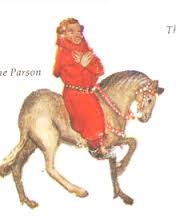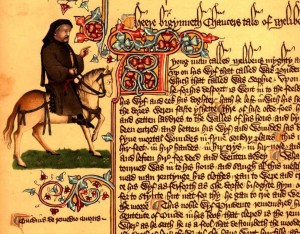The Parson’s Tale, the last of the tales in the Canterbury Tales is also one of the longest, and perhaps driest. Its difficulty is found within its form – it is essentially a treatise on morality broken into various smaller sections that are laborious to keep track of. I have found many students give up reading only a few small segments into the tale, out of utter frustration. Here is a breakdown of the tale that I hope makes it easier to follow along.
Part I
The Parson defines penitence – perfect penitence comes in three parts.
1. Contrition
Contrition is loathing of sin, with the goal of amendment, leading to eventual repentance.
There are two forms of contrition:
~~Contrition out of love for God
~~Contrition out of fear of being punished
Both of these forms require self acknowledgement. You cannot feel sadness for having sinned until you admit it. Nor can you fix the problem until you come to terms with it.
Enumeration Process Begins:
“The causes that oghte moeve a man to Contricion been six.”
~1. Remembering your sins – but not so in a boastful manner – always with sorrow
~2. Understanding that repentance frees the soul and thus wishing to be free
~3. Yes, repentance solely out of fear for punishment is not ideal, but how can we ignore that we will eventually be judged? So he describes the darkness of Hell.
There are three things that stand out most in Hell for which you will be punished: Glory, Pleasure, Riches
For Glory/Honor, in Hell there will be shame and confusion
For Pleasure (which comes from the five sense), there will be pain
For Riches there will be poverty in four parts: actual riches will be removed, lack of food, lack of clothes, solitude
~4. Remembering the good that could have been if you had not sinned – once you sin, if you do not repent all the goodness you had before will be lost
~5. Remembering that Christ died for your sins will drive you towards contrition because you do not wish his death to have been for nothing.
~6. The last thing that should move man towards Contrition is hope, specifically for three things:
~~to repent and actually be forgiven
~~the grace to live well and sin free once forgiveness is granted
~~to be admitted into Heaven
Next the Parson notes two types of sins for which Contrition is needed, even though they are not actual deeds
~1. Intention – sinful thought is as bad as actual sinning
~2. Speech – evil speech, even if never acted upon, is as bad as actual sinning
The last section in the part on Contrition reminds us that Contrition, in order to be effective, must lead to Confession, otherwise it is for nothing – similarly Confession without Contrition is just as useless.
2. Confession
Confession comes from true Contrition, both of which, due to our inherited original sin, are absolutely necessary for everyone.
For example, when temptation presents itself, even if we only consider it briefly before turning it down, it is still a sin. Further, if we resist temptation, but then are delighted by our willpower, this is pride, and also a sin.
There are two types of sins: venial and deadly
Venial – when you don’t love God enough, because you love something else more
Deadly – when you love something else enough to go against God
The rest of this section will be an outline of the seven deadly sins.
~1. Pride
Pride is the root of all sins. He describes all the ways in which pride manifests itself, including how we flaunt our worldly possessions (where he goes on a tirade against inappropriate and highly ornate clothing for ourselves and even our horses to the decadence of fine homes)
~~Remedy against Pride
~Humility in heart, mouth, and deeds
~~~in heart:
*understand that you are nothing outside of what God believes you are
*have no hatred towards others
*be considered as nothing by others, and care not
*experience humility and care not for the humiliation
~~~in mouth:
*do not speak too much
*do not brag
*use speech to praise good virtue
*speak only goodness, and never lie
~~~through deeds:
*remember to put others before you
*do not strive for worldly success
*when given advice, such as by priests or preachers, take it
*do not try to lead, but do what you are told by those morally superior
~2. Envy
Envy is malice and has two forms:
~~Hardness of Heart: meaning you do not care that you are committing a sin
~~Questioning Truth: believing there is more than one truth (as pertaining to the truth of God)
One of the differentiating traits of Envy is that it takes no delight in itself. When you practice gluttony/sloth/etc. you at least enjoy yourself while sinning. While practicing Envy you are in constant anguish as you covet what others have.
What is worse than coveting what others have, is wishing them harm for having it. He enumerates the ways in which this could be done:
~backbiting:
~~partaking in backhanded compliments
~~changing what someone good has said into gossip
~~if someone has done something good, refusing to acknowledge it
~~hearing a good man being praised for his goodness, and instead of participating in the praise stating that someone else is even better
~~participating in gossip
~Complaining against what God has given you, and consequently comparing yourself with another
The result of envy is bitterness of heart – you are causing yourself grief
~~Remedy for Envy
Love of God and then love of others – you will be less inclined to envy someone you love
~3. Anger
Anger stems from the other sins. The worst part of experiencing anger is wanting to cause harm to someone else. This is not to be confused with good anger (righteousness) in which you are angry against wickedness. However, you should not be angry towards a person for being wicked, but towards wickedness itself.
~Wicked anger (as opposed to righteousness) comes in two forms:
*Brief anger – something upsets you and you react
*Premeditated anger which is far worse
~The three off-shoots of anger:
*hate that is anger which has festered
*breaking ties through fighting
*war
Anger can also lead to manslaughter – in this section there is an outline of the different types of manslaughter that can essentially be divided between physical manslaughter, and spiritual manslaughter.
The next section is dedicated to contraception, abortion and infanticide – all are considered the same
We often make excuses for our anger, followed by a list of excuses men make
Anger leads to swearing. There are only three ways in which swearing is appropriate:
~in truth: taking an oath to self
~in truth: taking a lawful oath
~in righteousness: swearing to God
The last type of swearing is concerned with conjuring spirits. It must not be done unless it is done for an exorcism.
Anger leads to lying, followed by an outline of lies: to self, to others, through flattery
~~Remedy for Anger
Humility and patience
Humility must be practiced just as it was for the remedy to Pride
Patience has four ways of being practiced:
*for mean words spoken to you
*for harm towards your possessions
*for harm/violence to your body
*if given too much work (have patience, do not complain)
~4. Sloth
The worst about sloth is that it makes you slow, and therefore negligent when doing the work of Christ
Sloth is the enemy of the innocent man who needs to do Christ’s labor, enemy of the sinful man who needs to do labor for atonement, and enemy to the man who has grace and needs to do penitent labor
Sloth comes from despair/loss of hope – you believe you have sinned so much you cannot repent, and thus become lazy in performing good works.
Idleness is even worse than laziness.
~~Remedy for Sloth
Strength – which comes from the love of God
~5. Avarice
Greed comes from love of worldly things, and thus less love for God
Difference between greed and avarice:
*Greed – you want more
*Avarice – you want to keep what you already have
Both of these concepts are tied to excess, and also to idolatry (love of things)
The next section is dedicated to spiritual property and the buying/selling of relics
~~Remedy for Avarice
Mercy and pity, which roughly translate to charity (but do not perform charity as a means of gaining glory)
~6. Gluttony
Gluttony is to eat and drink to excess
The five types of gluttony:
~common drunkenness
~drunkenness to forget – as opposed to drunkenness because you like drinking
~overeating
~overeating for its own sake – as opposed to overeating because the food is too good to stop
~drinking beyond the point of mere drunkenness
The five ways of practicing gluttony:
~to eat before meal time
~eating delicacies that do not serve for nutrition
~eating/drinking beyond moderation
~desserts
~eating too fast
~~Remedy for Gluttony
Abstinence
~7. Lust /Lechery
Lust is an extension of gluttony – it is to want excess of physical pleasure
Different types of Lust/Lechery:
~Lechery is adultery – not only sinful in deed, but in desire for deed as well
~Any sexual relations between a man and woman who are not married (to each other)
~taking a virgin’s virginity (who is not your wife)
~a woman cheating on her husband is the vilest form – she is property and through lechery is also committing theft, giving the husband’s property to another man (should pregnancy occur, that is also theft)
~priests who break their vows of chastity
~all pleasure derived from physical activity
~contraception
~fantasy
Lechery, on the scale of sins, is somewhere between theft and manslaughter
~~Remedy for Lust/Lechery
Chastity
Then follows a section on being a good wife and then widow
This concludes the Seven Deadly Sins, and Part I of the Parson’s Tale
Part II
The first part was Contrition, or acknowledgement of sin. The second part is verbal Confession (continued from Part I).
2. Confession (continued)
When confessing a sin, everything about it must be confessed (who, what, why, when, where, how)
There are four conditions for confession:
~It must be done with shame – do not remember your sins fondly
~It must be done with humility
~You must weep for your sins
~Your confession should not be done in secret
Confession must be done as soon as the sin occurs
Confess to the same person each time so that he may know all of your sins
Do not lie during confession – makes it all pointless
Part III
Once Contrition and Confession occur, you must do your penance for sins committed.
3. Penance
Four ways of performing Penance:
~The most effective way of performing penance is through charity, not just of goods, but of time (volunteer)
~Prayer
~Fasting
~Physical strife (hair shirt, mutilation, etc.)
The four things which disturb Penance:
~Dread – being afraid of the suffering caused by penance
~Feeling shame for having to do Penance
~Hope for future (vs. immediate) repentance
~Despair from feeling that no matter how much penance you do, it will not be enough (therefore you give up and do none)
In conclusion to the Parson’s Tale he ends with the statement that true penitence, when followed through the three stages on a regular basis is the road to salvation.

